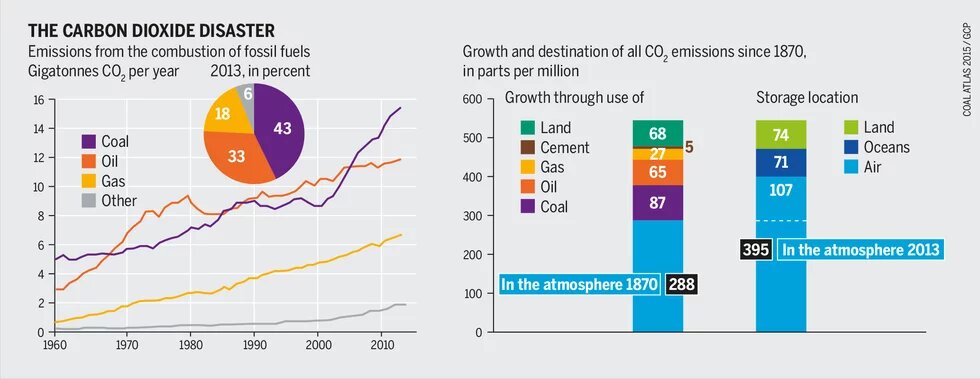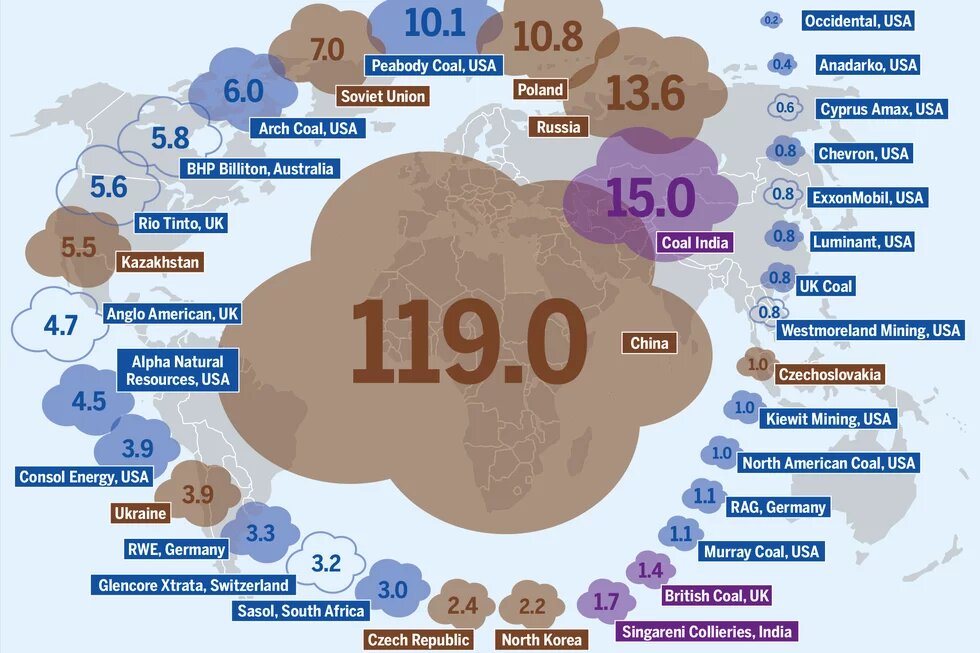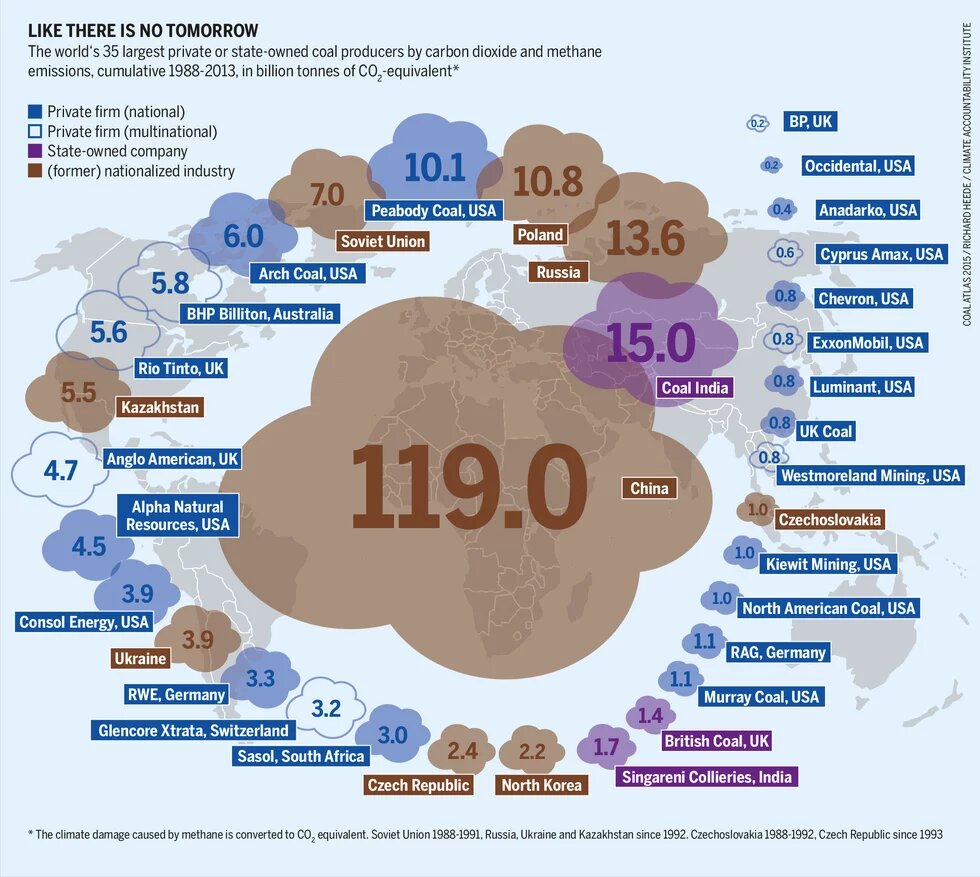

Digging up coal and using it to generate electricity churns out emissions that intensify the greenhouse effect. Coal is one of the biggest sources of climate change. A chapter from the Coal Atlas.
Greenhouse gases occur naturally in the atmosphere. They absorb part of the energy from the Earth’s surface and from clouds, preventing heat from escaping into space. Without this so-called greenhouse effect, the Earth would be a lot colder than it is. But since the Industrial Revolution, we have added sharply to the amount of carbon dioxide, methane and other greenhouse gases in the atmosphere: levels of CO2 in the air have gone up from 288 to 395 parts per million. Such concentrations boost the greenhouse effect.
The average global temperature has risen by 0.85 degrees Celsius since temperature records began. That may not sound like much, but the effects on our climate are considerable. Extreme weather such as droughts and heavy downpours are increasing. The mean sea level has risen by 19 cm since 1901. The Arctic ice pack is dwindling, the Greenland ice sheet has lost considerable mass, and glaciers worldwide are shrinking.
No other source of energy contributes as much to greenhouse gas emissions as coal. In 2014 it was responsible for emitting 14.2 gigatonnes of CO2. That is 44 percent of all energy-related carbon dioxide emissions, and more than one-quarter of all greenhouse gas emissions.
The 35 biggest coal producers have been responsible for one-third of the global emissions since 1988. This was the year the Intergovernmental Panel on Climate Change was founded, and the Toronto climate conference requested governments to set targets for reducing their emissions. The coal industry could no longer deny the harm its product was causing. Private companies, state-owned enterprises and government-run industries have made huge profits from producing and selling coal. But they have not been held accountable financially or legally for the loss and damage they have caused, and continue to cause, around the world.
The majority of coal is burned to produce heat and electricity. That releases a lot of carbon dioxide, along with smaller quantities of methane (CH4) and nitrous oxide (N2O). Different greenhouse gases have a different impact on the climate; converting them to a "CO2 equivalent" measure makes them comparable.
The amounts of CO2 and other greenhouse gases that escape into the atmosphere for each kilowatt-hour of electricity produced depend on the carbon content of the coal and the efficiency and operations of the power station. Only about one-third of the heat generated from burning is converted into electricity by turning water into steam that spins a turbine. A critical question is whether the power plant uses the residual warmth for heating purposes, or whether it merely releases it into the environment. In general, generating electricity from coal damages the climate most; gas-powered plants emit only half as much CO2 as modern coal-fired power stations.
The carbon footprint of coal is further enlarged by emissions of mine gas. This is created during the formation of the coal, and consists mainly of methane. In 2010, mines added the equivalent of another 500 million tonnes of CO2 to the atmosphere. In addition, hard coal often has to be transported long distances. That involves energy and contributes to the climate damage. Burning coal, whether in a power station, furnace or stove, releases soot particles that also fuel the greenhouse effect. Mining and transporting lignite produces fewer emissions. But using it to generate electricity still harms the climate more than hard coal. This is because lignite is less compact: it contains less energy - more has to be burned to produce the same amount of power.
Coal does not just feed power plants. It also goes into the blast furnaces of the iron and steel industry where it is converted into coke, which acts both as a fuel and a reducing agent to remove the oxygen from the iron oxide in the ore. This process also releases CO2.
With enough energy, coal can be transformed into a liquid or gas that can be used as a raw material in the chemicals industry or as a fuel-oil substitute. This is economically feasible only if oil prices are very high and coal prices very low. Only China, India and South Africa currently use this climate-damaging technology on a large scale.
There are already enough greenhouse gases in the atmosphere to raise the Earth’s average surface temperature by 1.5 degrees Celsius. This figure should not be exceeded, say scientists, nongovernment organisations and the nations that will be most affected, because doing so would jeopardize lives and livelihoods in many parts of the world.
If the temperature rises above that limit, the climate could cross a critical threshold. The permafrost at high latitudes could thaw, releasing the methane that it holds. The West Antarctic ice cap might melt. Such temperature thresholds are known as climate "tipping points". Beyond the tipping point, the climate would not return to its current state, but would undergo further changes that are impossible to predict.
At the Climate Change Conference in the Mexican city of Cancún in 2010, the international community agreed to limit temperature change to 2 degrees Celsius above pre-industrial levels. To have a 50 percent chance of keeping under this limit, the CO2 content of the atmosphere must be kept under 450 parts per million. That means that humanity must emit no more than 1,000 gigatonnes of CO2 by 2050. That is possible only if 88 percent of the currently confirmed coal reserves stay in the ground, along with one-third of the mineral oil and half the natural gas reserves. Our consumption of coal will have to fall
sharply, from 1.07 tonnes per person today to only 80 kilograms in 2050.
